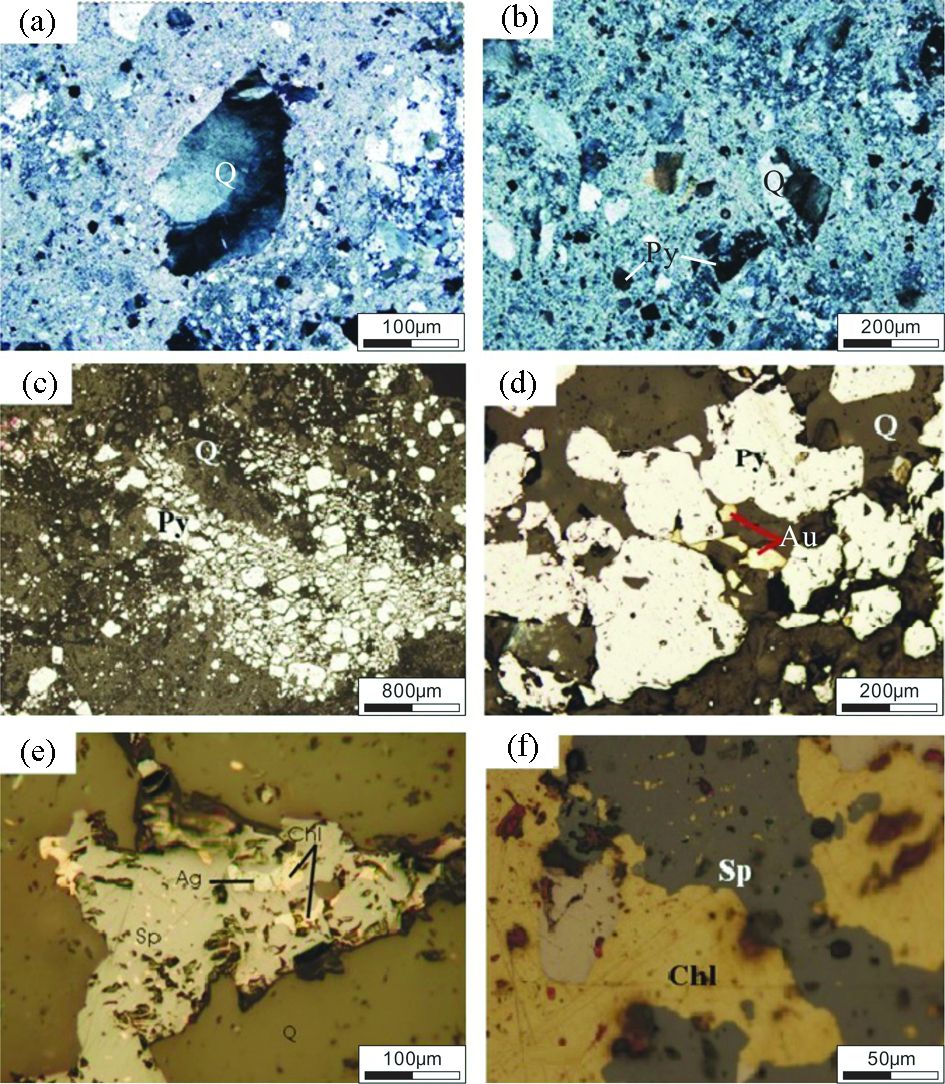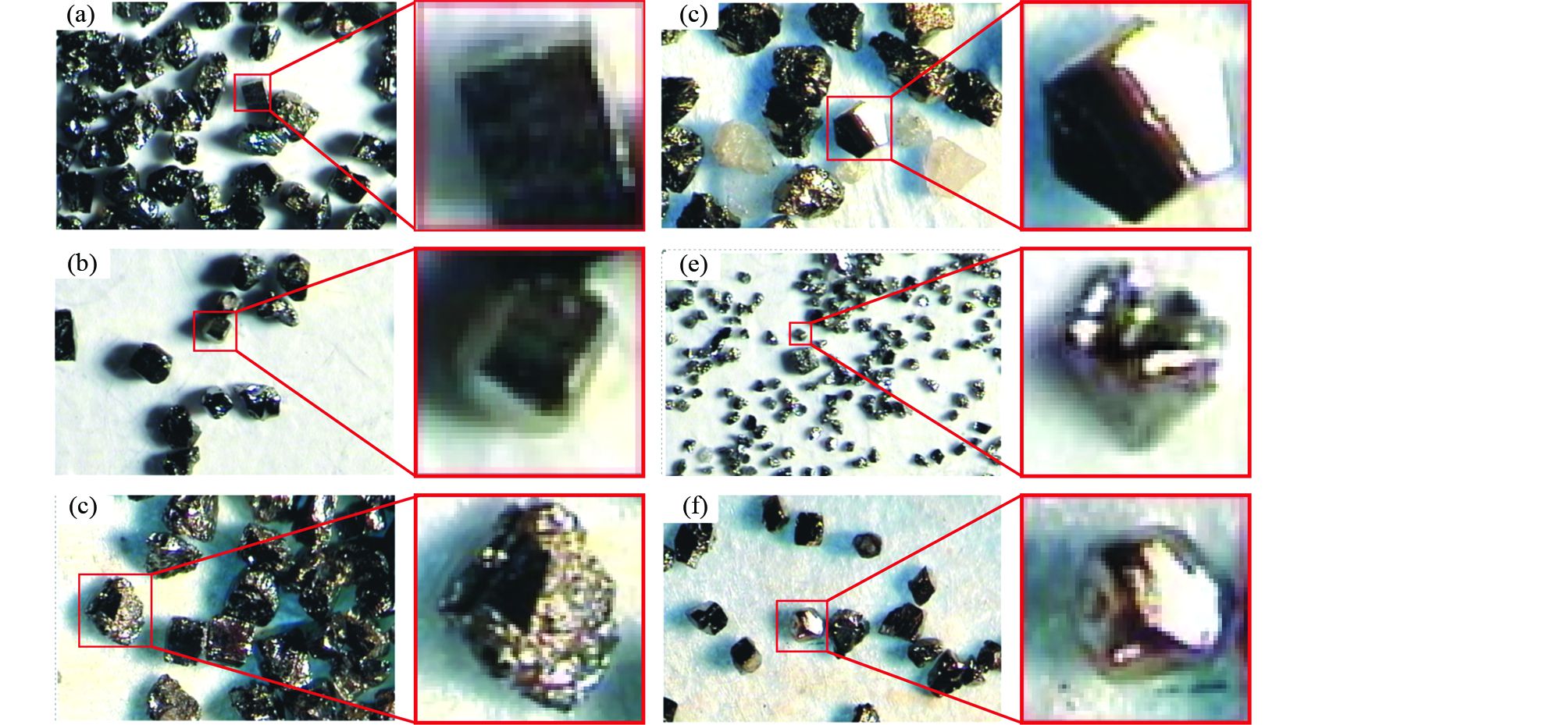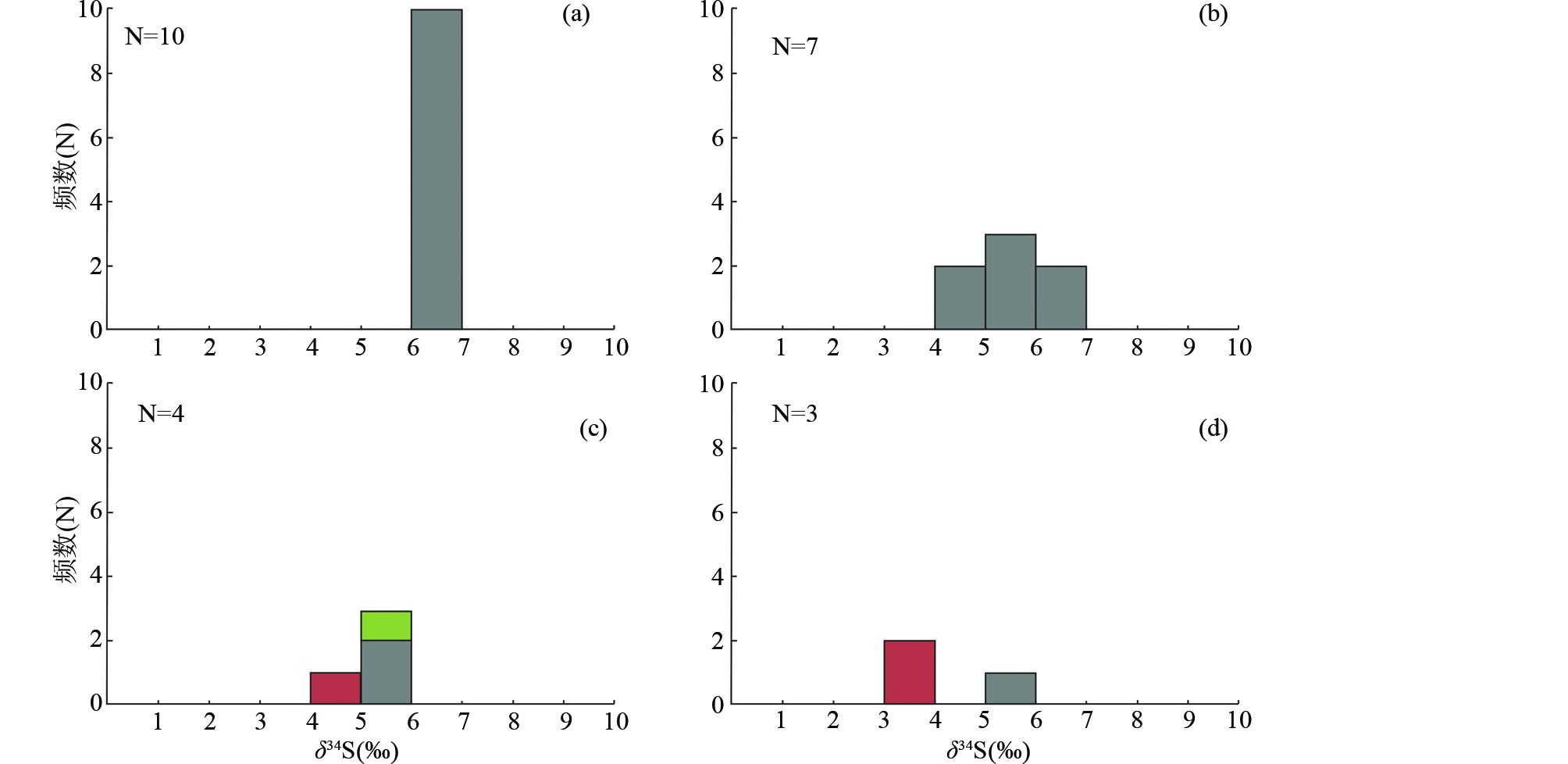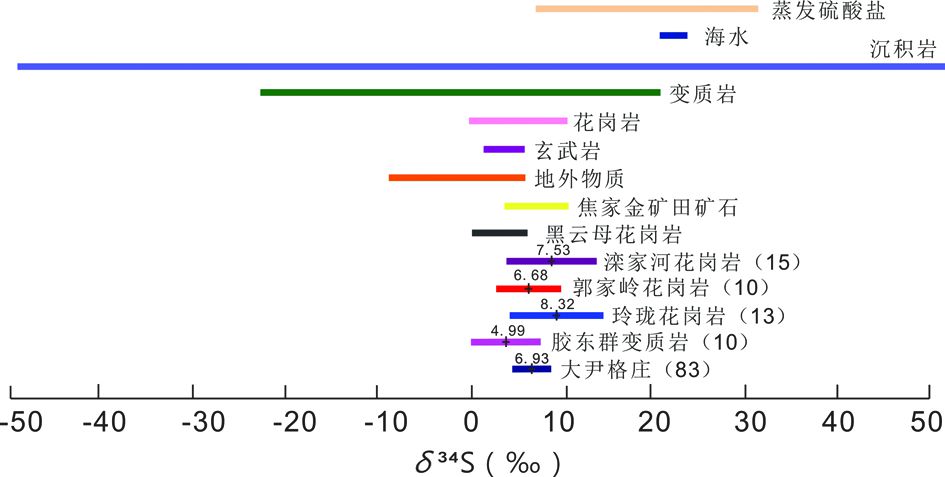2. 招金矿业股份有限公司, 招远 265400 ;
3. 招金矿业股份有限公司大尹格庄金矿, 招远 265413
2. Zhaojin Mining Industry Co., LTD., Zhaoyuan 265400, China ;
3. Dayingezhuang Gold Deposit, Zhaojin Mining Industry Co., LTD., Zhaoyuan 265413, China
胶东是我国最重要的金矿集中区,以“焦家式”金矿和“玲珑式”金矿享誉世界(杨立强等,2014)。其中,“焦家式”金矿是中国最主要的金矿床类型,占全国已探明超大型金矿床总数的50%以上,是指区域性断裂带中构造破碎的碎裂岩经热液蚀变矿化而形成的一种矿床类型(Yang et al.,2016a,c)。“焦家式”金矿类型的确立对我国金矿成矿理论和找矿实践产生了重要影响,而位于胶东金矿集区西北部招平金矿带中段的大尹格庄金矿床是典型的破碎带蚀变岩型金矿床(Deng et al.,2003,2009,2011;杨立强等,2007;Yang et al.,2007,2009,2014,2016b,d)。20世纪70年代以来,随着深部成矿理论及勘查技术方法发展(杨立强等,2006;宋明春等,2010;Yang and Badal,2013; Yang et al.,2015,2016e),该矿床的找矿勘查工作不断取得进展,目前勘探深度近-1600m,已探明金金属量约283t。前人对该金矿床已开展了控矿构造、岩浆岩、成矿物质、成矿流体等方面的研究(李德秀等,2006;高帮飞等,2007;江少卿,2007;潘红伟等,2008;张良等,2014),其中,对成矿物质来源的探讨主要是根据载金黄铁矿硫和铅同位素展开的。但是,由于黄铁矿为贯通性矿物,可以出现在各个成矿阶段,已有的硫同位素研究多数未将成矿期各个阶段的黄铁矿分别测试(杨金中和李光明,2001;邓军等,2005;罗镇宽等,2003;毛景文等,1999;刘育等,2014),获得的往往是多元混合的信息,很难得出有明确地质意义的硫同位素研究结果,因此不能有效反映各个成矿阶段的硫源及硫同位素的演化。另外,大尹格庄金矿床最主要的载金矿物黄铁矿存在多种晶体形态,甚至在同一成矿阶段也存在多种黄铁矿晶形。黄铁矿晶形特征除了受铁、硫元素地球化学性质及晶体结构决定外,还明显受到外界环境物理化学条件,如氧逸度(fO2)、硫逸度(fS2)、T(℃)和P(Pa)和介质盐度等条件的制约,因而,黄铁矿晶形标型特征可正确反映出其生成时的地质环境(蔡元吉和周茂,1993)。而且,热液含硫矿物的硫同位素组成不仅取决于源区硫同位素组成,而且也受到含硫物质在热液中迁移和矿物沉淀时的物理化学条件(氧逸度fO2、pH、离子强度和温度)的制约(Ohmoto,1972)。而已有黄铁矿硫同位素研究均未针对黄铁矿的晶体形态开展研究,其在一定程度上制约了硫同位素测试结果的可靠性分析和对成矿物质来源的科学理解。为此,本文在提供详细的成矿阶段划分依据基础上,详细观察了不同成矿阶段黄铁矿颗粒的晶形并分选出较为纯净的单矿物,对特定阶段的硫化物进行了硫同位素测定,厘定了不同晶形黄铁矿的硫同位素值可能存在的差异以及造成这种差异的原因,探讨了成矿物质来源与演化趋势。
2 区域与矿床地质胶西北基底岩石为太古宙TTG岩系及上元古界和下元古界变质碎屑岩系(Zhai and Santosh,2011;Zhou et al.,2008;Deng and Wang,2016; Yang et al.,2016f;图 1)。上元古界蓬莱群碎屑岩和碳酸盐岩不整合于下元古界荆山群和粉子山群之上,二者之间缺失中元古界地层(王中亮等,2011)。中生代的花岗质岩石覆盖了区内2/3以上的基岩露头,主要由160~150Ma的壳源的玲珑型黑云母花岗岩(Yang et al.,2012;Deng et al.,2015a)和132~126Ma的壳幔混合成因的郭家岭型似斑状花岗岩类组成(Hou et al.,2007;Yang et al.,2012),其内赋存了该区内几乎所有的金矿床。区内控矿构造主要是一系列沿玲珑型花岗岩体和胶东群变质岩接触带发育的NNE-NE向断裂(自西向东依次为三山岛断裂、焦家断裂和招平断裂)(Deng et al.,2015b;图 1),其最初是由古太平洋板块向北西斜向俯冲而形成的韧性逆断裂,随后在早白垩世燕山陆内张性变形过程中发生了脆性活化并伴随了金矿的形成(Goldfarb et al.,2013;Wang et al.,1998)。

|
图 1 招远-莱州金矿区地质图(据Wang et al.,2014修编) ①三山岛;②上庄;③北截;④丛家;⑤郭家岭 ① Sanshandao; ② Shangzhuang; ③ Beijie; ④ Congjia; ⑤ Guojialing Fig. 1 Geological map of the Zhaoyuan-Laizhou gold field(modified after Wang et al.,2014) |
大尹格庄金矿床位于胶西北招远市西南18km,处于招平断裂带的中段(图 1),截止到2015年底已开采金金属量约为45t,保有金金属量238t,累计探明金金属量约283t,目前年产量约2.6t。区内地层以太古宇胶东群和古元古代荆山群禄格庄组变质岩为主。矿区西部大面积出露玲珑花岗岩,其为大尹格庄金矿床的赋矿围岩。矿区内断裂构造以脆性变形构造为主,主要有招平断裂和大尹格庄断裂。其中,招平断裂在大尹格金矿床内沿胶东群与玲珑花岗岩接触带发育,其总体走向20°,倾向南东,倾角21°~58°,是大尹格金矿床的主要控矿构造。大尹格庄断裂走向280°,倾向北东,倾角43°~60°,其横穿并错断招平断裂,其北盘西移,水平断距260~300m,为成矿后断裂(图 2)。

|
图 2 大尹格庄金矿床地质简图(据Yang et al.,2014) Fig. 2 General geological map of the Dayingezhuang gold deposit(after Yang et al.,2014) |
大尹格庄金矿床矿体赋存在招平断裂下盘黄铁绢英岩化和碎裂岩化玲珑花岗岩中,主要由Ⅰ号和Ⅱ号矿体组成,分别位于大尹格庄断裂的南侧和北侧(图 2)。Ⅰ号矿体的规模仅次于Ⅱ号矿体,占总储量的34%,由18个分支矿体组成,呈不规则脉状或透镜状(图 3),赋存于招平断裂主裂面下的黄铁绢英岩化碎裂岩、黄铁绢英岩化花岗质碎裂岩、黄铁绢英岩化花岗岩中,金品位2~4.06g/t,平均2.96g/t。这些单一矿体走向18°~28°,平均20°,沿走向最大长度990m,最小长度450m,平均长度727m;倾向南东,倾角19°~42°,平均34°,矿体斜深247~1253m,平均916m,深部仍未封闭。矿石类型为黄铁绢英岩化碎裂岩、黄铁绢英岩化花岗岩。矿化形式主要为稠密浸染状,次为细脉浸染状及网脉状。黄铁矿主要呈星散状分布,少量为脉状、网脉状及斑点状分布。Ⅱ号矿体为矿床内的主要矿体,占矿床总储量59%,由73个分支矿体组成(图 3),呈不规则脉状、豆荚状,产出于招平断裂主裂面之下的黄铁绢英岩化碎裂岩中,局部延至黄铁绢英岩化花岗岩中,金品位2.1~3.73g/t,平均2.56g/t;其走向17°~26°,沿走向最大长度1057m,最小长度260m,平均765m;倾向南东,倾角18°~51°,平均39°,矿体斜深251~610m,平均469m,深部仍未封闭。矿石类型主要为黄铁绢英岩化碎裂岩,局部为黄铁绢英岩化花岗岩。矿化形式主要为稠密浸染状,次为细脉浸染状和网脉状,黄铁矿主要呈星散状、斑点状、脉状及网脉状分布。

|
图 3 大尹格庄金矿床矿体地质平面图(a)、Ⅰ号(b)和Ⅱ号(c)矿体地质剖面图 Fig. 3 Geological map of the Dayingezhuang gold deposit(a),geological section map of ore body I(b)and ore body Ⅱ(c) |
大尹格金矿床内Ⅰ号矿体和Ⅱ号矿体具有相似的矿物组成,其矿石主要矿物是绢云母、石英、黄铁矿,次要矿物是方解石、黄铜矿、方铅矿、闪锌矿、磁黄铁矿、黝铜矿和自然金、自然银、金银矿、碲银矿等(Yang et al.,2014)。其中,硫化物占矿物总含量的5~50%,黄铁矿是最主要的含金矿物。根据穿插关系和矿物共生组合,大尹格庄金矿床内成矿作用可划分为4个成矿阶段,分别是黄铁矿-石英-绢云母阶段(I)、石英-黄铁矿阶段(Ⅱ)、石英-多金属硫化物阶段(Ⅲ)和石英-方解石-多金属硫化物阶段(Ⅳ)(图 4)。

|
图 4 大尹格庄金矿床成矿阶段及主要矿物共生次序 线的粗细代表矿物的相对含量 The thickness of the line represents the relatⅣe content of the mineral Fig. 4 Mineralization stages and paragenetic sequences of main minerals in Dayingezhuang gold deposit |
黄铁矿-石英-绢云母阶段(I)的矿物主要由石英组成,有少量黄铁矿、绢云母。该阶段的石英-粗粒黄铁矿脉切穿成矿前石英-钾长石脉(图 5a)。其中石英具明显的韧性变形、脆性变形及强烈波状消光(图 6a),黄铁矿嵌布在石英的集合体内(图 6b)。本阶段金矿化微弱,见有极少量自然金呈圆粒状包于黄铁矿内。

|
图 5 大尹格庄金矿床床内矿脉穿插关系 (a)Ⅰ阶段黄铁矿石英脉切穿成矿前石英钾长石脉;(b)Ⅱ阶段石英黄铁矿细脉切穿Ⅰ阶段黄铁矿石英脉和成矿前石英钾长石脉;(c)钾化蚀变花岗岩中的浸染状或细脉状黄铁矿化(Ⅱ阶段);(d)黄铁绢英岩中的多金属硫化物矿化(Ⅲ阶段);(e)(银)石英多金属硫化物脉切穿Ⅲ阶段的多金属硫化物矿化脉,其又切穿Ⅱ阶段的石英黄铁矿细脉;(f)(银)石英-铅锌矿细脉(Ⅳ阶段) (a)pyrite quartz vein of stage I. Vein cut through feldspar quartz vein;(b)pyrite quartz veinlet of stage Ⅱ. Vein cut through pyrite quartz vein of stage I and feldspar quartz vein;(c)disseminated pyrite or veinlets of pyrite(stage Ⅱ)in the potassium granite;(d)sulphides mineralization(stage Ⅲ)in the phyllic;(e)(silver)quartz sulfide vein cut through sulfide vein of stage Ⅲ and pyrite quartz veinlet of stage Ⅱ;(f)(silver)quartz-lead-zinc veinlets of stage Ⅳ Fig. 5 Interspersed relationship of veins in Dayingezhuang gold deposit |

|
图 6 大尹格庄金矿床矿石标本的反射光和透射光显微照片 (a)石英波状消光;(b)嵌布在石英的集合体内的Ⅰ阶段黄铁矿;(c)压碎结构,早阶段黄铁矿在应力作用下被压碎;(d)晶隙金,石英和黄铁矿晶隙间的金矿物;(e)闪锌矿中的黄铜矿和银;(f)乳浊状结构,黄铜矿、闪锌矿的固溶体分离.Chl-黄铜矿;Q-石英;Py-黄铁矿;Au-金;Ag-银;Sp-闪锌矿 (a)quartz wavy extinction;(b)pyrites of stage I disseminated in quartz;(c)crushing structure,pyrite of early stage were crushed under stress;(d)gilds in fracture,gold minerals between quartz and pyrite;(e)chalcopyrite and freibergites in sphalerite;(f)emulsion-like structure,solid solution separation of chalcopyrite and sphalerite. Chl-chalcopyrite; Q-quartz; Py-pyrite; Au-gold; Ag-silver; Sp-sphalerite Fig. 6 Reflected light and transmitted light micrograph of samples in Dayingezhuang gold deposit |
石英-黄铁矿阶段(Ⅱ)主要矿化产物为黄铁矿组成,并含有少量石英、绢云母、自然金及银金矿,形成的矿化物组合为金+石英+绢云母+黄铁矿。其中黄铁矿呈自形、半自形晶体、浸染状、细脉浸染状及细脉状分布;石英呈半自形柱状、粒状,嵌布在黄铁矿石英晶隙中。本阶段是矿区金的主要沉淀期。早期阶段形成的黄铁矿、石英等被挤压、压碎(图 6c)。其中浸染状者发育广泛,见于碎裂岩和花岗岩中,以前者为主,形成黄铁绢英岩化碎裂岩;细脉状者一般仅见于花岗岩内,主要发育在Ⅱ号矿体群中(图 5b,c)。
石英-多金属硫化物阶段(Ⅲ)矿化产物主要由石英、黄铁矿、黄铜矿、方铅矿、闪锌矿组成,并含少量银金矿、金银矿、磁黄铁矿、黝铜矿、辉铜铋矿、自然铋等,矿物组合复杂(图 6d,e)。一般呈团块状分布(图 5d)。其中石英呈灰色,半自形粒状,嵌布于黄铁矿晶隙中;黄铁矿晶隙中常被黄铜矿、闪锌矿、方铅矿、银金矿充填。黄铜矿与闪锌矿常构成乳浊结构(图 6f)。此阶段亦伴随有金的沉淀,叠加在前阶段之上形成金的局部富集。
石英-方解石-多金属硫化物阶段(Ⅳ)为主要的银矿化阶段,该阶段热液矿化脉体呈细脉状、脉状或不均匀团块状分布在早期蚀变带内(图 5e,f)。矿化产物主要由石英、黄铁矿、方铅矿、闪锌矿组成,并含有少量黄铜矿、自然银、碲银矿、辉银矿等,矿物组成复杂。
3 样品采集与分析方法将野外采集的样品进行观察描述,在详细的岩相学和矿相学工作对大尹格庄金矿床成矿阶段进行细致划分的基础上,选择代表性样品,进行磨片和单矿物分选。本次研究的样品分别采集于矿床的-210m、-247m、-290m、-309m、-356m等5个不同的中段,用于测试分析的样品为各个成矿阶段的蚀变岩石、矿石及石英碳酸盐脉共21件样品(样品岩性见表 1、表 2、表 3)。在通过光学显微镜观察黄铁矿的产出形式及和其他矿物之间的关系基础上,进一步采用双目镜观察黄铁矿颗粒的晶形并分选出较为纯净的单矿物。
|
|
表 1 大尹格庄金矿床各个成矿阶段黄铁矿的晶体形态特征 Table 1 Crystal forms of pyrite in different mineralization in Dayyingezhuang gold deposit |
|
|
表 2 大尹格庄金矿床不同成矿阶段黄铁矿电子探针分析结果(wt%) Table 2 Results of electron probe analysis of pyrite in different mineralization stages in Dayingezhang gold deposit(wt%) |
|
|
表 3 大尹格庄金矿床矿石的硫同位素分析结果 Table 3 Results of sulfur isotope of ore in Dayingezhang gold deposit |
黄铁矿的电子探针分析在中国地质大学(北京)电子探针室完成,仪器型号为日本岛津公司制造EPMA-1600。测试条件为:定量加速电压15kV,束斑电流2×10-8A,束斑直径0.5μm,峰值计算时间20~60s。采用ZAF法修正数据,分析准确度小于1%。
硫化物硫同位素测试由核工业北京地质研究院分析测试研究中心完成,分别使用MAT251与MAT253同位素质谱仪利用(Giesemann et al.,1994)的方法对不同矿体各个成矿阶段的硫化物样品硫同位素进行分析。硫同位素采用CDT标准,用δ34S来表示,测试精度为±0.2‰。
4 分析结果 4.1 载金黄铁矿标型特征 4.1.1 形态标型各个成矿阶段的黄铁矿的晶体形态特征见表 1和图 7。从表 1和图 7中可以看出,成矿Ⅰ阶段黄铁矿多数呈自形粒状,颗粒粗大,粒径为1~4cm,裂纹发育,具压碎结构;形态简单,仅出现{100}、{210}和{100}+{210},其中以{100}占绝对多数。成矿Ⅱ阶段黄铁矿呈半自形-自形粒状,颗粒较细,粒径为0.1~0.5mm,裂纹不太发育;形态复杂,主要为{210}、{210}+{100},其次为{100}、{210}+{100}+{111}及{100}+{111};黄铁矿晶体晶面条纹发育,晶面相对较粗糙,并且歪晶普遍发育,或出现多晶体连生的现象,其中聚形晶中各单形晶面比例有较大差别。成矿Ⅲ阶段黄铁矿呈半自形-他形,颗粒细小,粒径一般不大于0.1mm,以大量出现{310}+{100}和{210}+{100}为特征;邻界面发育,常使晶棱和晶面长成弧形,且晶面条纹较发育,晶体常沿某个方向沿长,长成歪晶。成矿Ⅳ阶段黄铁矿呈自形粒状,颗粒细小,粒径小于0.1mm;形态简单,主要为{100},少量为{210}。

|
图 7 大尹格庄金矿床矿不同成矿阶段黄铁矿双目镜下的晶体形态 (a)立方体黄铁矿{100}(红色框内,下同);(b)黄铁矿立方体、八面体聚形{100} +{111};(c)立方体黄铁矿;(d)五角十二面体黄铁矿;(e)黄铁矿立方体、八面体聚形{100} +{111};(f)五角十二面体、立方体、八面体聚形{210}+{100}+{111} (a)cubic pyrite {100}(pyrite in the red frame);(b)combination shape pyrite of cubic pyrite and Octahedral pyrite {100} +{111};(c)cubic pyrite;(d)pentagonal dodecahedron pyrite;(e)combination shape pyrite of cubic pyrite and Octahedral pyrite {100} +{111};(f)combination shape pyrite of pentagonal dodecahedron pyrite,cubic pyrite and octahedral pyrite {210}+{100}+{111} Fig. 7 Crystal form of pyrite in different mineralization stages under binocular in Dayingezhuang gold deposit |
各个成矿阶段的黄铁矿的电子探针分析结果见表 2。从表 2可以看出,黄铁矿S元素含量为51.25%~53.12%,平均值为52.39%,小于理论值53.45%,Fe元素含量为45.89%~47.65%,平均值为46.51%,小于理论值46.55%。
4.1.3 微量元素标型黄铁矿中微量元素包括两部分:一是呈类质同象替代形式进入黄铁矿晶格的元素,如替代Fe的Co、Ni元素和替代S的As、Se、Te等元素;二是呈机械混入物形式存在于黄铁矿中的元素,如Au、Ag、Cu、Pb、Zn等元素。
从表 2可以看出,不同成矿阶段黄铁矿中的微量元素含量有明显的差异。其中,高温元素Co、Ni在成矿早阶段(Ⅰ阶段)黄铁矿中富集,为0.95%~1.04%,Ⅱ、Ⅲ阶段依次减少,分别为0.12%~0.47%和0.05%~0.06%。中温元素Cu在成矿主阶段(Ⅱ、Ⅲ阶段)较富集,而在第Ⅰ阶段含量较低,未被检出。
4.2 硫同位素组成大尹格庄金矿床的硫化物硫同位素分析结果见表 3和图 8。从表 3和图 8可以看出,该矿床的硫化物δ34S介于4.58‰~7.54‰,均值为6.71‰,其中,黄铁矿的δ34S值变化于5.50‰~7.54‰,极差2.04‰;闪锌矿的δ34S值为6.86‰;方铅矿的δ34S值变化于4.58‰~4.99‰,极差0.41‰;其δ34S值变化范围窄,以富34S、变异小和明显的塔式分布为特征,但各个成矿阶段硫化物δ34S值略有不同。其中成矿Ⅰ阶段黄铁矿的δ34S介于7.18‰~7.54‰,均值为7.306‰;成矿Ⅱ阶段黄铁矿的δ34S介于5.5‰~7.4‰,均值为6.65‰;成矿Ⅲ阶段硫化物的δ34S介于4.99‰~6.86‰,其中两个黄铁矿的δ34S分别为6.57‰和6.82‰,1个闪锌矿的δ34S为6.86‰,1个方铅矿的δ34S为4.99‰;成矿Ⅳ阶段的1个黄铁矿的δ34S为6.98‰,2个方铅矿的δ34S分别为4.58‰和4.61‰。

|
图 8 大尹格庄金矿床各个成矿阶段矿石矿物硫同位素组成 (a)成矿Ⅰ阶段;(b)成矿Ⅱ阶段;(c)成矿Ⅲ阶段;(d)成矿Ⅳ阶段 (a)Stage I;(b)Stage Ⅱ;(c)Stage Ⅲ;(d)Stage Ⅳ Fig. 8 Sulfur isotopic composition of ore minerals of different mineralization stages in Dayingezhang gold deposit |
大尹格金矿床的硫同位素分析结果(表 3和图 8)表明,取自不同矿体的硫化物的δ34S值集中在4.58‰~7.54‰,具有一定的塔式效应,正向偏离陨石硫,且各个成矿阶段硫化物的δ34S值比较接近,说明硫同位素值均一化程度很高,指示大尹格庄金矿床矿石硫源是一致的。结合前人对胶东地区胶东群变质岩、围岩花岗岩类硫同位素分析结果(表 4),可以发现它们都具有正向偏离陨石硫、分布相对集中的特征,从胶东群变质岩至中生代花岗岩,硫同位素组成呈现重硫含量逐渐增高的趋势,且接近于大尹格庄金矿床矿石硫同位素值(图 9);揭示了大尹格金矿床矿石硫与胶东群变质岩和中生代花岗岩间的继承演化关系。另外,区内中生代花岗岩和矿石矿物黄铁矿的δ34S值均在自然体系中花岗岩及变质岩的硫同位素组成的范围之内(图 9),也指示大尹格庄金矿床矿石硫与胶东群变质岩和中生代花岗岩间的继承演化关系。
|
|
表 4 胶东地区地层和花岗岩类的硫同位素分析结果 Table 4 Sulfur isotope analysis of strata and granite in Jiaodong area |

|
图 9 胶东地区胶东群变质岩、花岗岩类和大尹格庄金矿床硫同位素组成特征(据王中亮,2012修编) ()内的数字表示样品数,+数字表示平均值 Values in()represent the number of samples,values above + represents the mean value Fig. 9 Sulfur isotope composition of Jiaodong group metamorphic rocks,granites and samples of Dayingezhuang gold deposit in the Jiaodong area(modified after Wang,2012) |
大尹格庄金矿床矿石硫化物的δ34S值介于胶东群变质岩和中生代花岗岩之间,可能是成矿作用过程中,流体的物理化学条件影响硫同位素的分馏所致。尽管成矿期内硫化物δ34S值分布范围总体上较为集中(4.58‰~7.54‰),而各成矿阶段黄铁矿硫同位素组成不同,从Ⅰ阶段→Ⅱ阶段→Ⅲ阶段→Ⅳ阶段,黄铁矿δ34S值总体上呈现出逐渐降低的趋势(表 3、图 8),指示不同成矿阶段热液流体的pH值、Eh值、氧逸度(fO2)、硫逸度(fS2)等物理化学条件及矿物的形成温度不同(Murowchick and Barnes,1987)。在平衡条件下,硫化物中δ34S的富集顺序为:Bi2S3 <Sb2S3 <Cu2S<PbS<Cu5FeS4 <CuFeS2<ZnS<FeS1-x<FeS2<MoS2(郑永飞和陈江峰,2000),而大尹格庄金矿床成矿Ⅲ阶段硫化物硫同位素值变化范围相对较宽(4.99‰~6.86‰),且黄铁矿的δ34S 值(6.57‰和6.82‰)小于闪锌矿的δ34S(6.86‰),不符合硫化物中δ34S 的富集顺序(黄铁矿>闪锌矿),指示在多金属硫化物阶段局部共生硫化物间硫同位素处于不平衡状态,这可能指示大尹格金矿床的主成矿阶段成矿物理化学条件发生了急剧变化(王义文等,2002)。而成矿Ⅳ阶段同时形成的硫化物的δ34S值满足δ34SPy>δ34SGn,表明在成矿晚阶段不同硫化物间硫同位素分馏基本达到了平衡。
5.2 成矿的物理化学条件各个成矿阶段的黄铁矿的晶体形态标型研究表明,成矿Ⅰ阶段黄铁矿以粗粒自形立方体为主,还有少量五角十二面体(表 1),指示成矿Ⅰ阶段的成矿环境为较高温度(330~350℃)、快速冷却、低过饱和度、低氧逸度和硫逸度条件(陈光远等,1987;蔡元吉和周茂,1993;李楠等,2012)。成矿Ⅱ和Ⅲ阶段黄铁矿以细粒五角十二面体为主,且具有更多的五角十二面体、八面体和立方体形成的聚形,表明黄铁矿形成于中温(200~300℃)、成矿流体过饱和度高、高氧逸度和硫逸度,缓慢冷却同时物质供应充分的成矿环境(陈光远等,1987;蔡元吉和周茂,1993)。成矿晚阶段主要为细粒立方体晶形,表明该阶段处于较低温度(<200℃),热液流体过渡饱和度较低、低氧逸度和硫逸度、同时物质供应不足的成矿环境。这与Yang et al.(2009)测得不同成矿阶段流体包裹体的均一温度分别为310~360℃、240~270℃和140~200℃的结果基本一致。不同成矿阶段黄铁矿中的微量元素研究表明,成矿早阶段(Ⅰ阶段)黄铁矿中的Co、Ni元素比较集中,Ⅱ、Ⅲ阶段依次减少,而中温元素Cu在成矿主阶段(Ⅱ、Ⅲ阶段)较富集,而在Ⅰ阶段含量较低,其指示成矿Ⅰ阶段→Ⅱ阶段→Ⅲ阶段是一个成矿流体温度逐渐降低的连续过程。
前已述及,成矿Ⅳ阶段硫化物之间硫同位素达到了分馏平衡,因而可视其满足硫同位素平衡且封闭体系内质量平衡的条件。考虑到大尹格庄金矿床成矿流体盐度约为10%(Yang et al.,2009),因而成矿热液离子强度I为1.0(程伟基和支霞臣,1983)。因此,可以应用图 10估算成矿Ⅳ阶段的成矿热液氧逸度。依据Ⅳ阶段黄铁矿δ34S值,结合Yang et al.(2009)得到的大尹格庄金矿床成矿Ⅳ阶段pH值6,可得到成矿Ⅳ阶段成矿流体的氧逸度约为10-36.7(图 10)。

|
图 10 大尹格金矿床成矿Ⅳ阶段lgfO2-pH-δ34Spy图(据Ohmoto,1972) 温度T=200℃,离子强度I=1.0条件下.1:Fe-S-O矿物相界线(∑S=0.1mol/kg H2O);2:Fe-S-O矿物相界线(∑S=0.001mol/kg H2O);3:在δ34S∑S=+10‰时,黄铁矿的δ34Si等值线 T=200℃ and I=1.0. 1: Fe-S-O mineral boundaries at ∑S=0.1mol/kg H2O; 2: Fe-S-O mineral boundaries at ∑S=0.001mol/kg H2O; 3: δ34Si contours for pyrite δ34S∑S=+10‰ Fig. 10 lgfO2-pH-δ34Spy diagram of ore stage Ⅳ in Dayingezhuang gold deposit(after Ohmoto,1972) |
(1) 成矿Ⅰ阶段黄铁矿以粗粒自形立方体为主,含有少量五角十二面体;成矿Ⅱ和Ⅲ阶段黄铁矿以细粒五角十二面体为主,且具有更多五角十二面体、八面体和立方体形成的聚形;成矿Ⅳ阶段主要为细粒立方体晶形。
(2) 从成矿Ⅰ阶段→Ⅱ阶段→Ⅲ阶段→Ⅳ阶段,大尹格庄金矿床矿石硫化物δ34S呈现出逐渐降低的趋势,然不同矿体各个成矿阶段的矿石硫源总体一致,与胶东群变质岩和中生代花岗岩间具有继承演化关系。
(3) 大尹格庄金矿床成矿Ⅰ阶段→Ⅱ阶段→Ⅲ阶段→Ⅳ阶段是一个成矿流体温度逐渐降低的连续过程,其中Ⅰ阶段处于较高温度(330~350℃)、快速冷却、低过饱和度、低氧逸度和硫逸度的成矿环境;Ⅱ和Ⅲ阶段黄铁矿形成于中-低温(200~300℃)、成矿流体过饱和度高、高氧逸度和硫逸度,缓慢冷却同时物质供应充分的成矿环境;Ⅳ阶段处于较低温度(<200℃)、热液流体过饱和度较低、低氧逸度和硫逸度、同时物质供应不足的成矿环境。
(4) 大尹格庄金矿床主成矿阶段成矿物理化学条件发生了急剧变化,导致成矿ⅢⅣ阶段局部共生硫化物间硫同位素处于不平衡状态;成矿Ⅳ阶段不同硫化物间硫同位素分馏基本达到平衡,δ34S值满足δ34SPy>δ34SGn,成矿流体的氧逸度约为10-36.7。
致谢 中国地质大学(北京)邓军教授和杨立强教授在论文撰写过程中提出了宝贵意见;招金矿业股份有限公司大尹格庄金矿郭永超等地质工程师在野外工作中给予了大力支持和帮助;两位匿名审稿人提出了宝贵的修改意见;在此一并表示感谢。| [1] | Cai YJ, Zhou M. 1993. Crystalomorphological characteristics of pyrite in hydrothermal gold deposit:An experimental study. Science in China (Series B) , 23 (9) :972–978. |
| [2] | Chen GY, Sun DS, Zhang L, Zang WS, Wang J, Lu AH. 1987. Morphogenesis of pyrite. Geoscience , 1 (1) :60–76. |
| [3] | Cheng WJ, Zhi XC. 1983. Physicochemical properties and sulfur isotope evolution of hydrothermal system-theory, application and using method of lgfo2-pH-δSi34 diagram. Geology and Prospecting (9) :21–29. |
| [4] | Deng J, Yang LQ, Sun ZS, Wang JP, Wang QF, Xin HB, Li XJ. 2003. A metallogenic model of gold deposits of the Jiaodong granite-greenstone belt. Acta Geologica Sinica , 77 (4) :537–546. |
| [5] | Deng J, Wang QF, Yang LQ, Gao BF. 2005. An analysis of the interior structure of the gold hydrothermal metallogenic system of the northwestern Jiaodong Peninsula, Shandong Province. Earth Science , 30 (1) :102–108. |
| [6] | Deng J, Yang LQ, Gao BF, Sun ZS, Guo CY, Wang QF, Wang JP. 2009. Fluid evolution and metallogenic dynamics during tectonic regime transition:Example from the Jiapigou gold belt in Northeast China. Resource Geology , 59 (2) :140–153. DOI:10.1111/rge.2009.59.issue-2 |
| [7] | Deng J, Wang QF, Wan L, Liu H, Yang LQ, Zhang J. 2011. A multifractal analysis of mineralization characteristics of the Dayingezhuang disseminated-veinlet gold deposit in the Jiaodong gold province of China. Ore Geology Reviews , 40 (1) :54–64. DOI:10.1016/j.oregeorev.2011.05.001 |
| [8] | Deng J, Wang CM, Bagas L, Carranza EJM, Lu YJ. 2015a. Cretaceous-Cenozoic tectonic history of the Jiaojia Fault and gold mineralization in the Jiaodong Peninsula, China:Constraints from zircon U-Pb:Illite K-Ar and apatite fission track thermochronometry. Mineralium Deposita , 50 (8) :987–1006. DOI:10.1007/s00126-015-0584-1 |
| [9] | Deng J, Liu XF, Wang QF, Pan RG. 2015b. Origin of the Jiaodong-type Xinli gold deposit, Jiaodong Peninsula, China:Constraints from fluid inclusion and C-D-O-S-Sr isotope compositions. Ore Geology Reviews , 65 :674–686. DOI:10.1016/j.oregeorev.2014.04.018 |
| [10] | Deng J, Wang QF. 2016. Gold mineralization in China:Metallogenic provinces, deposit types and tectonic framework. Gondwana Research , 36 :219–274. DOI:10.1016/j.gr.2015.10.003 |
| [11] | Gao BF, Yang LQ, Wang QF. 2007. Ore-controlling microstructure characteristics of Dayingezhuang gold deposit in Jiaodong Peninsula. Gold , 28 (1) :9–12. |
| [12] | Giesemann A, Jager HJ, Norman AL, Krouse HR, Brand WA. 1994. Online sulfur-isotope determination using an elemental analyzer coupled to a mass spectrometer. Analytical Chemistry , 66 (18) :2816–2819. DOI:10.1021/ac00090a005 |
| [13] | Goldfarb RJ, Santosh M, Deng J, Yang LQ. 2013. The giant Jiaodong gold deposits, china:Orogenic gold in a unique tectonic setting or a unique gold deposit type?. New Developments in Structural and Tectonic Controls on Ore , 45 (7) :298. |
| [14] | Hou ML, Jiang YH, Jiang SY, Ling HF, Zhao KD. 2007. Contrasting origins of late Mesozoic adakitic granitoids from the northwestern Jiaodong Peninsula, East China:Implications for crustal thickening to delamination. Geological Magazine , 144 :619–631. DOI:10.1017/S0016756807003494 |
| [15] | Huang DY. 1994. Research on sulfur isotopes of Jiaodong gold mineralization system. Mineral Deposits , 13 (1) :75–87. |
| [16] | Jiang SQ. 2007. Magnetic Fabric and fluid inclusion plane of the gold deposit in Zhaoping fault zone, Shandong, China:Implication for process of structure-fluid evolution and gold mineralization. Master Degree Thesis. Beijing:China University of Geosciences (in Chinese with English summary) |
| [17] | Li DX, Gao BF, Liu Y, Zhou YH, Jiang SQ, Xu FY, Zhu YR, Yu RY, Xu JL, Wang CH, Zhang RZ, Wu Z. 2006. Structural controls and ore prospecting in the Dayingezhuang gold deposit. Geology and Prospecting , 42 (4) :32–35. |
| [18] | Li N, Yang LQ, Zhang C, Zhang J, Lei SB, Wang HT, Wang HW. 2012. Sulfur isotope characteristics of the Yangshan gold belt, West Qinling:Constraints on ore-forming environment and material source. Acta Petrologica Sinica , 28 (5) :1577–1587. |
| [19] | Liu Y, Yang LQ, Guo LN, Li RH, Gao BF, Meng YS, Zhang RZ. 2014. Composition of ore-forming fluids in the Dayingezhuang gold deposit of the Jiaodong Peninsula, China. Acta Petrologica Sinica , 30 (9) :2507–2517. |
| [20] | Li ZL, Yang MZ.1993. The Geology-Geochemistry of Gold Deposits in Jiaodong Region. Tianjin: Tianjin Science and Technology Press : 1 -300. |
| [21] | Luo ZK, Guan K, Yu HY, Li YM. 2003. The key factors for formation of large-superlarge au deposits in Zhaolai area, Jiaodong region. Contributions to Geology and Mineral Resources Research , 18 (2) :95–102. |
| [22] | Mao JW, Hua RM, Li XB. 1999. A preliminary study of large-scale metallogenesis and large clusters of mineral deposits. Mineral Deposits , 18 (4) :291–299. |
| [23] | Murowchick JB, Barnes HL. 1987. Effects of temperature and degree of supersaturation on pyrite morphology. American Mineralogist , 72 :1241–1250. |
| [24] | Ohmoto H. 1972. Systematics of sulfur and carbon isotopes in hydrothermal ore deposits. Economic Geology , 67 (5) :551–578. DOI:10.2113/gsecongeo.67.5.551 |
| [25] | Pan HW, Zhang RZ, Fan MY. 2008. Ore-controlling effects of NWW trending faults in Dayingezhuang gold deposit, Shandong Province. Gold , 29 (1) :21–24. |
| [26] | |
| [27] | Wang LG, Qiu YM, McNaughton NJ, Groves DI, Luo ZK, Huang JZ, Miao LC, Liu YK. 1998. Constraints on crustal evolution and gold metallogeny in the Northwestern Jiaodong Peninsula, China, from SHRIMP U-Pb zircon studies of granitoids. Ore Geology Reviews , 13 (1) :275–291. |
| [28] | Wang YW, Zhu FS, Gong RT. 2002. Study on the metallogenic chronology of gold deposits in Jiaodong gold concentration zone. Gold Geology , 8 (4) :48–55. |
| [29] | Wang ZL, Gong QJ, Yang LQ, Zhou Z, Ma XD. 2011. Timing of structural-thermal events in the Wang'ershan gold deposit, eastern Shandong:Evidence from field investigations. Geology and Prospecting , 47 (6) :1067–1076. |
| [30] | Wang ZL. 2012. Metallogenic system of Jiaojia gold orefield, Shandong Province, China. Ph. D. Dissertation. Beijing:China University of Geoscience (in Chinese with English summary) |
| [31] | Wang ZL, Yang LQ, Deng J, Santosh M, Zhang HF, Liu Y, Li RH, Huang T, Zheng XL, Zhao H. 2014. Gold-hosting high Ba-Sr granitoids in the Xincheng gold deposit, Jiaodong Peninsula, East China:Petrogenesis and tectonic setting. Journal of Asian Earth Sciences, 95:274-299 |
| [32] | Yang JZ, Li GM. 2001. Comparison of different mineralizations in Mesozoic and its significence in Jiaodont region, Shandong Province. Geology and Prospecting , 37 (1) :33–37. |
| [33] | Yang KF, Fan HR, Santosh M, Hu FF, Wilde SA, Lan TG, Lu LN, Liu YS. 2012. Reaction of the Archean lower crust:Implications for zircon geochronology, elemental and Sr-Nd-Hf isotopic geochemistry of Late Mesozoic granitoids from northwestern Jiaodong Terrane, the North China Craton. Lithos , 146-147 :112–127. DOI:10.1016/j.lithos.2012.04.035 |
| [34] | Yang LQ, Deng J, Wang QF, Gao BF, Xu H. 2006. Deep-seated tectonic and geological process controls on mineralization and mineral resources. Mineral Deposits , 25 (Suppl.1) :107–110. |
| [35] | Yang LQ, Deng J, Zhang J, Wang QF, Gao BF, Zhou YH, Guo CY, Jiang SQ. 2007. Preliminary studies of fluid inclusions in Damoqujia gold deposit along Zhaoping fault zone, Shandong Province, China. Acta Petrologica Sinica , 23 (1) :153–160. |
| [36] | Yang LQ, Deng J, Ge LS, Wang QF, Zhang J, Gao BF, Jiang SQ, Xu H. 2007. Metallogenic epoch and genesis of the gold deposits in Jiaodong Peninsula, eastern China:A regional review. Progress in Natural Science , 17 (2) :138–143. DOI:10.1080/10020070612331343237 |
| [37] | Yang LQ, Deng J, Guo CY, Zhang J, Jiang SQ, Gao BF, Gong QJ, Wang QF. 2009. Ore-forming fluid characteristics of the Dayingezhuang gold deposit, Jiaodong gold province, China. Resource Geology , 59 (2) :181–193. DOI:10.1111/rge.2009.59.issue-2 |
| [38] | Yang LQ, Badal J. 2013. Mirror symmetry of the crust in the oil/gas region of Shengli, China. Journal of Asian Earth Sciences , 78 :327–344. DOI:10.1016/j.jseaes.2013.05.001 |
| [39] | Yang LQ, Deng J, Goldfarb RJ, Zhang J, Gao BF, Wang ZL. 2014. 40Ar/39Ar geochronological constraints on the formation of the Dayingezhuang gold deposit:New implications for timing and duration of hydrothermal activity in the Jiaodong gold province, China. Gondwana Research , 25 (4) :1469–1483. DOI:10.1016/j.gr.2013.07.001 |
| [40] | Yang LQ, Deng J, Wang ZL, Zhang L, Guo LN, Song MC, Zheng XL. 2014. Mesozoic gold metallogenic system of the Jiaodong gold province, eastern China. Acta Petrologica Sinica , 30 (9) :2447–2467. |
| [41] | Yang LQ, Deng J, Dilek Y, Qiu KF, Ji XZ, Li N, Taylor RD, Yu JY. 2015. Structure, geochronology, and petrogenesis of the Late Triassic Puziba granitoid dikes in the Mianlue Suture Zone, Qinling Orogen, China. The Geological Society of America Bulletin , 127 :1831–1854. DOI:10.1130/B31249.1 |
| [42] | Yang LQ, Deng J, Guo RP, Guo LN, Wang ZL, Chen BH, Wang XD. 2016a. World-class Xincheng gold deposit:An example from the giant Jiaodong gold province. Geoscience Frontiers , 7 (3) :419–430. DOI:10.1016/j.gsf.2015.08.006 |
| [43] | Yang LQ, Deng J, Guo LN, Wang ZL, Li XZ, Li JL. 2016b. Origin and evolution of ore fluid, and gold-deposition processes at the giant Taishang gold deposit, Jiaodong Peninsula, eastern China. Ore Geology Reviews , 72 :585–602. DOI:10.1016/j.oregeorev.2015.08.021 |
| [44] | Yang LQ, Deng J, Wang ZL, Guo LN, Li RH, Groves DI, Danyushevsky LY, Zhang C, Zheng XL, Zhao H. 2016c. Relationships between gold and pyrite at the Xincheng gold deposit, Jiaodong Peninsula, China:Implications for gold source and deposition in a brittle epizonal environment. Economic Geology , 111 (1) :105–126. DOI:10.2113/econgeo.111.1.105 |
| [45] | Yang LQ, Deng J, Wang ZL, Zhang L, Goldfarb RJ, Yuan WM, Weinberg RF, Zhang RZ. 2016d. Thermochronologic constraints on evolution of the Linglong Metamorphic Core Complex and implications for gold mineralization:A case study from the Xiadian gold deposit, Jiaodong Peninsula, eastern China. Ore Geology Reviews , 72 :165–178. DOI:10.1016/j.oregeorev.2015.07.006 |
| [46] | Yang LQ, Deng J, Li N, Zhang C and Yu JY. 2016e. Isotopic constraints on sources and ore genesis of gold deposits in the Yangshan Gold Belt, West Qinling, central China. Journal of Geochemical Exploration, 168:103-118 |
| [47] | Yang LQ, Guo LN, Wang ZL, Zhao RX, Song MC and Zheng XL. 2016f. Timing and mechanism of gold mineralization at the Wang'ershan gold deposit, Jiaodong Peninsula, eastern China. Ore Geology Reviews, doi.10.1016/j.oregeorev.2016.06.027 |
| [48] | Zhai MG, Santosh M. 2011. The Early Precambrian odyssey of the North China Craton:A synoptic overview. Gondwana Research , 20 (1) :6–25. DOI:10.1016/j.gr.2011.02.005 |
| [49] | Zhang L, Liu Y, Li RH, Huang T, Zhang RZ, Chen BH, Li JK.2014. Lead isotope geochemistry of Dayingezhuang gold deposit, Jiaodong Peninsula, China. Acta Petrologica Sinica. : 2468 -2480. |
| [50] | Zheng YF, Chen JF.2000. Stable Isotope Geochemistry. Beijing: Science Press : 1 -316. |
| [51] | Zhou JB, Wilde SA, Zhao GC, Zheng CQ, Jin W, Zhang XZ, Cheng H.2008. SHRIMP U-Pb zircon dating of the Neoproterozoic Penglai Group and Archean gneisses from the Jiaobei Terrane, North China, and their tectonic implications. Precambrian Research. : 323 -340. |
| [52] | 蔡元吉, 周茂.1993. 金矿床黄铁矿晶形标型特征实验研究. 中国科学(B辑) , 23 (9) :972–978. |
| [53] | 陈光远, 孙岱生, 张立, 臧维生, 王健, 鲁安怀.1987. 黄铁矿成因形态学. 现代地质 , 1 (1) :60–76. |
| [54] | 程伟基, 支霞臣.1983. 热液系统的物理化学性质和硫同位素演化——lgfo2-pH-δSi34图解的原理、用途与使用方法. 地质与勘探 (9) :21–29. |
| [55] | 邓军, 王庆飞, 杨立强, 高帮飞.2005. 胶东西北部金热液成矿系统内部结构解析. 地球科学 , 30 (1) :102–108. |
| [56] | 高帮飞, 杨立强, 王庆飞.2007. 胶东大尹格庄金矿床控矿显微构造特征. 黄金 , 28 (1) :9–12. |
| [57] | 黄德业.1994. 胶东金矿成矿系列硫同位素研究. 矿床地质 , 13 (1) :75–87. |
| [58] | 江少卿. 2007. 招平断裂带金矿床构造-流体演化-磁组构与流体包裹体面约束. 硕士毕业论文. 北京:中国地质大学 |
| [59] | 李德秀, 高帮飞, 刘琰, 周应华, 江少卿, 徐福玉, 朱悦荣, 于瑞业, 徐建利, 王翠红, 张瑞忠, 吴忠.2006. 大尹格庄金矿床构造控矿规律及找矿意义. 地质与勘探 , 42 (4) :32–35. |
| [60] | 李楠, 杨立强, 张闯, 张静, 雷时斌, 王恒涛, 王宏伟.2012. 西秦岭阳山金矿带硫同位素特征:成矿环境与物质来源约束. 岩石学报 , 28 (5) :1577–1587. |
| [61] | 刘育, 杨立强, 郭林楠, 李瑞红, 高帮飞, 孟银生, 张瑞忠.2014. 胶东大尹格庄金矿床成矿流体组成. 岩石学报 , 30 (9) :2507–2517. |
| [62] | 李兆龙, 杨敏之. 1993. 胶东金矿床地质地球化学. 天津: 天津科学技术出版社 : 1 -300. |
| [63] | 罗镇宽, 关康, 余和勇, 李永明.2003. 胶东招莱地区大-超大型金矿床形成的几个关键因素. 地质找矿论丛 , 18 (2) :95–102. |
| [64] | 毛景文, 华仁民, 李晓波.1999. 浅议大规模成矿作用与大型矿集区,. 矿床地质 , 18 (4) :291–299. |
| [65] | 潘红伟, 张瑞忠, 樊明玉.2008. 山东大尹格庄金矿NWW向断裂控矿作用浅析. 黄金 , 29 (1) :21–24. |
| [66] | 宋明春, 崔书学, 伊丕厚, 徐军祥, 袁文花, 姜洪利. 2010. 胶西北金矿集中区深部大型-超大型金矿找矿与成矿模式. 北京: 地质出版社 . |
| [67] | 王义文, 朱奉三, 宫润潭.2002. 胶东金矿集中区金矿成矿年代学研究. 黄金地质 , 8 (4) :48–55. |
| [68] | 王中亮, 龚庆杰, 杨立强, 周铸, 马学东.2011. 胶东望儿山金矿床构造-热事件时序:野外地质证据. 地质与勘探 , 47 (6) :1067–1076. |
| [69] | 王中亮. 2012. 焦家金矿田成矿系统:博士学位论文. 北京:中国地质大学, 1-230 |
| [70] | 杨金中, 李光明.2001. 胶东中生代两期金矿化作用的对比研究及其意义. 地质与勘探 , 37 (1) :33–37. |
| [71] | 杨立强, 邓军, 王庆飞, 高帮飞, 徐浩.2006. 深部构造与地质过程控矿研究. 矿床地质 , 25 (S1) :107–110. |
| [72] | 杨立强, 邓军, 张静, 王庆飞, 高帮飞, 周应华, 郭春影, 江少卿.2007. 山东招平断裂带大磨曲家金矿床流体包裹体初步研究. 岩石学报 , 23 (1) :153–160. |
| [73] | 杨立强, 邓军, 王中亮, 张良, 郭林楠, 宋明春, 郑小礼.2014. 胶东中生代金成矿系统. 岩石学报 , 30 (9) :2447–2467. |
| [74] | 张良, 刘跃, 李瑞红, 黄涛, 张瑞忠, 陈炳翰, 李金奎.2014. 胶东大尹格庄金矿床铅同位素地球化学. 岩石学报 , 30 (9) :2468–2480. |
| [75] | 郑永飞, 陈江峰. 2000. 稳定同位素地球化学. 北京: 科学出版社 : 1 -316. |
 2016, Vol. 32
2016, Vol. 32


